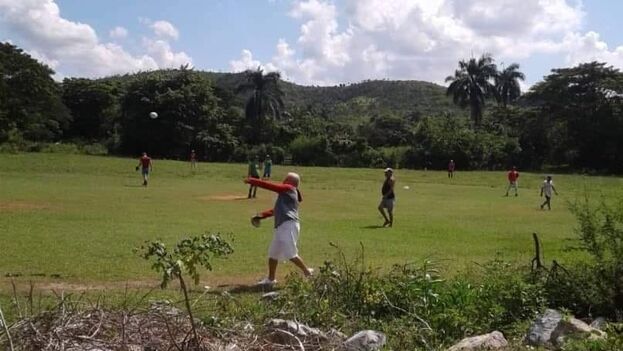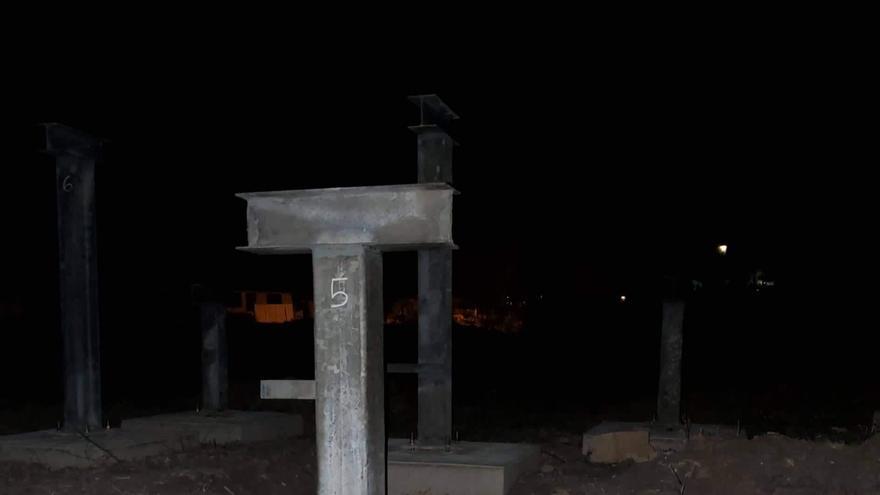
14ymedio, Havana, 28 March 2023 — Residents of Puerto Escondido, in the province of Mayabeque, Cuba, no longer know who to turn to, or how else to report what they are experiencing. Constant gas leaks, deterioration of the vegetation due to hydrocarbon contamination and, finally, the installation of concrete reinforced piles for a gas pipeline in the only baseball field in the town, have exhausted the residents’ patience with the Energas company.
“Until a few years ago, one would say the name of this town, and what came to mind were natural beauties, the sea and fun, but Cupet has taken part of that away from us,” laments Dayamí, who agrees to tell 14ymedio what they are living with in the town, although her name was changed for fear of reprisals. “The stench of oil in the air is constant,” she adds.
In Puerto Escondido there is a plant managed by the mixed Cuban-Canadian company, Energas S.A., which is managed by the official companies Cupet and Unión Eléctrica, together with the Canadian company Sherritt. It is a raw gas processing plant and a turbine, to which is added an electrical generator with a power of 20 megawatts. The energy stability of various hotel facilities in the area depends on the latter.

“This used to be a paradise, but now even the grass is dying, the lemon trees are dying and the leaves of the trees get covered with spots and stay looking as if they were burned. If that happens to the plants, imagine what will be happening to our lungs?” Complains Dayamí, 32, who has two small children, one of them, asthmatic “who is constantly having crises because one can no longer breathe clean air around here.”
Gas production from oil from the Energas plant is transferred through a pipeline between Puerto Escondido and the Boca de Jaruco plant, both of which supply manufactured gas to part of the city of Havana. At the beginning of this year, a pipeline breakdown caused a leak and left part of the Cuban capital without service. For the residents of Puerto Escondido, that kind of incident seems like a “daily occurrence,” the woman denounces.
“Some of the gas treated in the Boca de Jaruco and Puerto Escondido facilities is sent to Havana to cook food for around 280,000 families. Likewise, the Energas plants produce other fundamental components for the national economy, such as LPG, naphtha and sulfur,” Edel Andrés Alfaro Pérez, economic manager of Energas, recently strutted.
But Dayamí does not see the operation of the plant with such optimistic eyes: “People feel this stench of gas everywhere when there is a leak, but we live surrounded by that smell. When we leave here and move to other municipalities, we carry that plague with us. When I visit my mother, who lives in La Lisa, I always have to take off all my clothes and shower when I get there because I smell of burning oil.”
“As if that were not enough, what they have done in recent days is an unprecedented insult,” adds another resident of the municipality, who sent a complaint to the newsroom of 14ymedio. “They [Energas] have taken the right that nobody gave them to cross the only baseball field, where the town’s adults and children play”.
Outdoor space for practicing sports is “the only thing that exists in the town because they have never built anything in the last decades, they have not even paved the only dirt road that exists in Puerto Escondido… They have crisscrossed the baseball field with concrete piles supposedly for the construction of an elevated pipeline,” she explains, and accompanies her testimony with images where the structures that rise from the ground which will support the pipeline can be seen.

For this local resident, it is an outrage that no one consulted the residents about the new work. “No one spoke to anyone or took the realization of said pipeline to a vote. It is disrespectful,” she stresses. “They are practically the owners of everything and they do what they want without counting on anyone, without respect for anything or anyone. They took away our clean air and now they have also damaged the ball field.”
“They have to stop this work because, in this batey*, there is nothing else for the children to have fun. We need them to be able to continue playing baseball,” claims the neighbor, whose parents and grandparents were also born in Puerto Escondido. “Here there is no park, or computer center or anything. Young people and adults enjoyed this ball field.”
It was recently announced that the Cuban Government, as part of the payment of a debt of 368 million dollars to the Canadian Sherritt, approved a 20-year extension of the contract of the mixed company Energas, until March 2043, so that the extraction of gas in Puerto Escondido it is far from being something temporary, and the residents of the town are seeing how the industrial works continue to gain ground.
“Two weeks ago, they began to extract soil and lay the foundations for these piles, they have crossed our town from one side to the other and also the ball field” details the neighbor who wrote to this newspaper. “The pipe will remain in the open air, elevated on those columns. People are afraid of accidents, leaks, and they are also very upset, sad, and humiliated.”
“Here, even the Royal Poincianas, also called flamboyán trees, are dying, because wisps of gas are constantly coming out of the [oil] plant,” explains the resident. “This was a very natural town; we had several popular campsites but most of them are already closed. Who is going to be interested now in coming to a town with the stench of oil and with a gas pipe running through it?” he asks.
*Translator’s note: Batey was the name given to a special plaza, around which the Caribbean Taíno Indians built their settlements. It was usually a rectangular area surrounded by stones with carved symbols (petroglyphs). The Batey was the area in which ceremonies, ball games, etc.) took place.
Translated by Norma Whiting
____________
COLLABORATE WITH OUR WORK: The 14ymedio team is committed to practicing serious journalism that reflects Cuba’s reality in all its depth. Thank you for joining us on this long journey. We invite you to continue supporting us by becoming a member of 14ymedio now. Together we can continue transforming journalism in Cuba.
